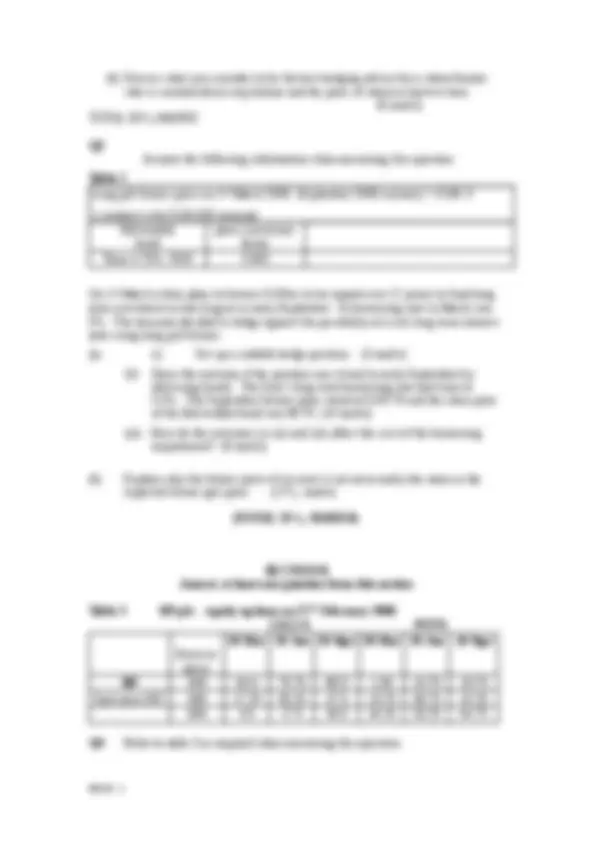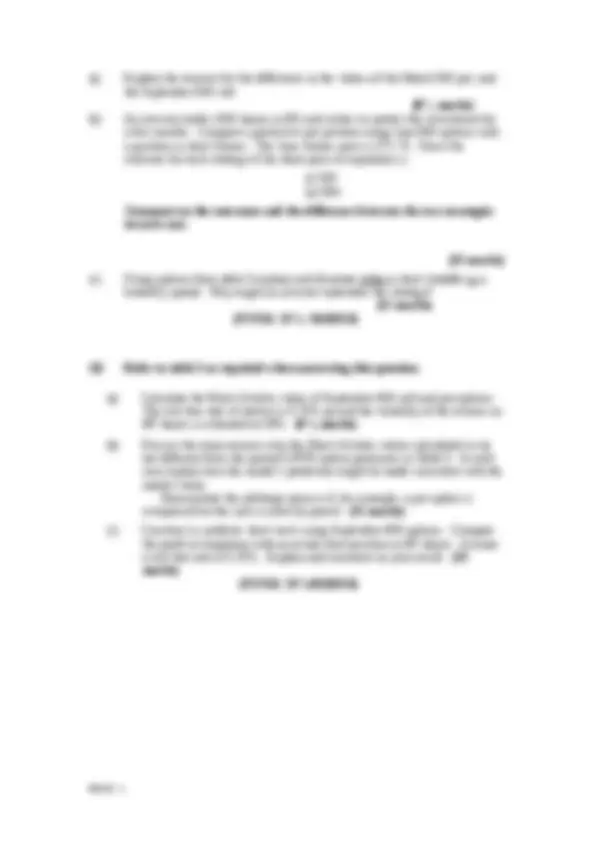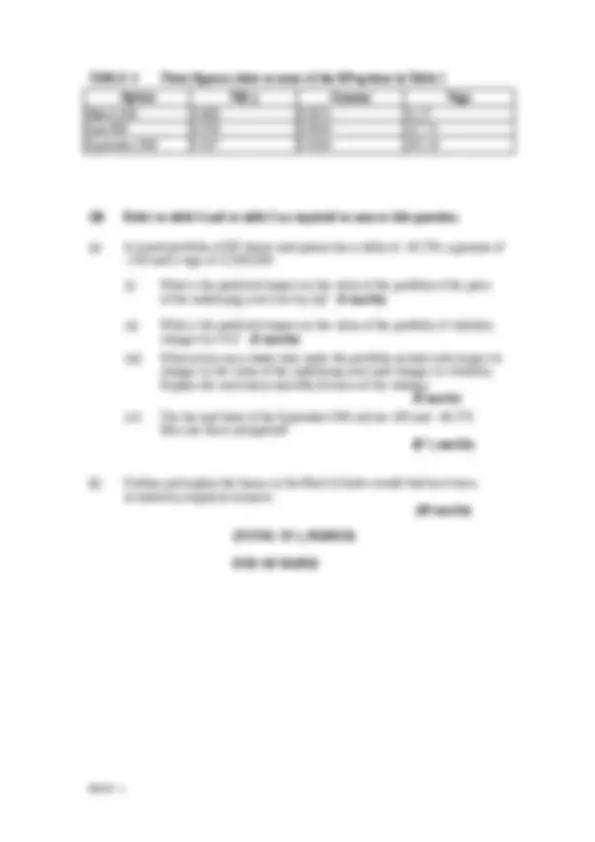





Study with the several resources on Docsity

Earn points by helping other students or get them with a premium plan


Prepare for your exams
Study with the several resources on Docsity

Earn points to download
Earn points by helping other students or get them with a premium plan
Community
Ask the community for help and clear up your study doubts
Discover the best universities in your country according to Docsity users
Free resources
Download our free guides on studying techniques, anxiety management strategies, and thesis advice from Docsity tutors
The questions and answers for an options and futures exam from the msc finance program at the university of cambridge, department of accounting and finance. The exam covers topics such as futures pricing, hedging, and option valuation using the black-scholes model. Students are required to answer three questions, each with multiple parts, using provided data and formulas.
Typology: Study notes
1 / 5

This page cannot be seen from the preview
Don't miss anything!




Answer at least one question from this section
(a) On 27 th^ February 2008 the British Airways futures price for the 19 th December 2008 contract was 278.11. BA expected to pay two dividends of 7p per share in the coming months, due in 75 and 225 days time. Assume the continuously compounded annual risk free rate of interest was 5.25%.
(i) Estimate the spot price of BA shares on 27 th^ February. (8 marks)
(ii) Suppose the quoted December futures price was 270 rather than the correct 278.11. Explain and illustrate the arbitrage opportunity this offers. Use the spot price calculated in (i). (10 marks)
(b) Explain and demonstrate the convergence property of futures prices. (7 1 / 3 marks)
(c) Demonstrate that a perfect hedge earns the risk free rate. (8 marks)
Table 1 Short term interest rates and futures prices on 27 th^ February 2008
Spot rates 3 months 6 months 1 year
LIBOR 5. 7% 5.66% 5.54%
Futures prices 19th^ March contract 18th^ June contract 17th^ Sept contract
3-month sterling 94.24 94.61 94. One contract is for £500,000 nominal
(a) It is 27th^ February 2008. A corporate treasurer expects a cash inflow of £120million in the next few months, probably in early June. It will then be deposited for three months before it is committed to long term investment. The treasurer wishes to hedge against an unexpected large fall in short term interests rates when the time comes to deposit the money.
(i) Set up a hedge position using June futures. (3 marks)
(ii) Show the outcome if 3-month LIBOR had fallen to 4.95% in early June when the money arrived, and the June futures price was then 95.03. ( marks)
(iii) Show the outcome if the LIBOR had risen to 6%, and the futures price had fallen to 94.01. (4^1 / 3 marks)
(iv) Compare the two outcomes (ii) and (iii), and assess whether the hedge was effective in each case. (6 marks)
(v) Estimate the ‘fair’ price for the June futures contract, and compare with the quoted price. (8 marks)
(a) Explain the reasons for the difference in the values of the March 500 put, and the September 500 call. (8^1 / 3 marks) (b) An investor holds 1000 shares in BP, and wishes to protect the investment for a few months. Compare a protective put position using June 600 options with a position in short futures. The June futures price is 571.70. Show the outcome for each strategy if the share price at expiration is: (i) 500 (ii) 650. Comment on the outcomes and the difference between the two strategies in each case.
(13 marks) (c) Using options from table 3 explain and illustrate either a short straddle or a butterfly spread. Why might an investor undertake the strategy? (12 marks) (TOTAL 33 1 / 3 MARKS)
Q5 Refer to table 3 as required when answering this question.
(a) Calculate the Black-Scholes value of September 600 call and put options. The risk free rate of interest is 5.25% pa and the volatility of the returns on BP shares is estimated at 28%. (6 1 / 3 marks)
(b) Discuss the main reasons why the Black-Scholes values calculated in (a) are different from the quoted LIFFE option premiums in Table 3. In each case explain how the model’s prediction might be made consistent with the market value. Demonstrate the arbitrage process if, for example, a put option is overpriced but the call is correctly priced. (15 marks) (c) Construct a synthetic short stock using September 600 options. Compare the profit at expiration with an actual short position in BP shares. Assume a risk free rate of 5.25%. Explain and comment on your result. ( marks) (TOTAL 33^1 / (^) 3MARKS)
TABLE 4 These figures relate to some of the BP options in Table 1 Option N(d (^) 1) Gamma Vega
March 500 0.963 0.0021 11.
June 600 0.376 0.0044 117.
September 560 0.557 0.0034 162.
Q6 Refer to table 4 and to table 3 as required to answer this question.
()a A mixed portfolio of BP shares and options has a delta of –45,750, a gamma of –240 and a vega of 12,500,000.
(i) What is the predicted impact on the value of the portfolio if the price of the underlying asset rises by 4p? ( 6 marks)
(ii) What is the predicted impact on the value of the portfolio if volatility changes by ¼%? (3 marks) (iii) What action can a trader take make the portfolio neutral with respect to changes in the value of the underlying asset and changes in volatility. Explain the motivation and effectiveness of the strategy. ( 8 marks ) (iv) The rho and theta of the September 500 call are 190 and −49.275. How are these interpreted? (6 1 / 3 marks)
(b) Outline and explain the biases in the Black-Scholes model that have been revealed by empirical research. (10 marks)
(TOTAL 33 1 / 3 MARKS)